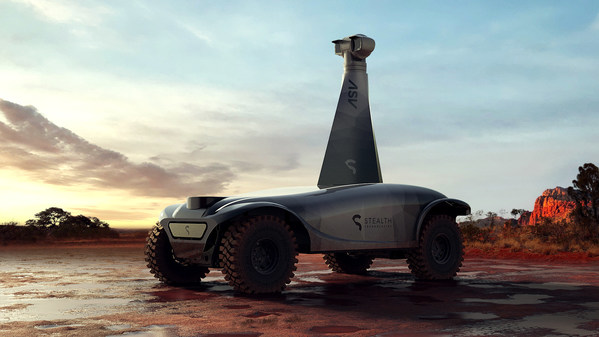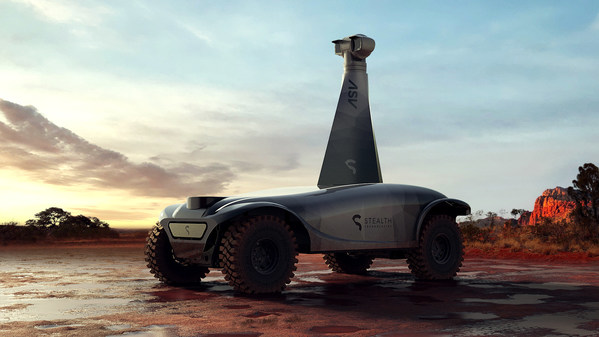 |
PERTH, Australia, Dec. 23, 2021 /PRNewswire/ — Strategic Elements Ltd (ASX: SOR) is pleased to report that the 100% owned Stealth AxV Automation & Robotics Platform successfully achieved multiple development and program milestones across the Autonomous Security Vehicle (ASV), Autonomous CBRN Agent Detection and Autonomous Mining applications under development.
Managing Director Charles Murphy said "Stealth Technologies has built a world first automation and robotics technology for the correctional sector to increase security, save costs and re-deploy staff away from mundane, repetitive tasks. It is satisfying that real world outcomes are starting to be reported that indicate the robustness and reliability of the ASV. I know that Stealth truly values the industry knowledge shared by the Honeywell team and the autonomous vehicle expertise of key professors and researchers at UWA".
"It’s a good example of a start-up with innovative IP, a large Company with domain knowledge and a research organisation with deep expertise coming together to solve a real, customer identified problem. We have a direct line with domain knowledge for Autonomous CBRN Detection by working with DSTG and are keen to replicate this experience in the mining sector where we are in the early stages of a relationship with a global mining Company".
Autonomous Security Vehicle for the Correctional Sector
Stealth Technologies is collaborating with global Fortune 100 software-industrial company Honeywell to develop autonomous security vehicles for the correctional sector. The ASV seamlessly integrates into the prison’s security management platform and can autonomously navigate pre-defined missions to test key Perimeter Intrusion Detection Systems (PIDS) including photo-electric beams, microphonic and fibre-optic fence sensors, buried electromagnetic cables and microwave beams. Patrol surveillance is provided by a military grade camera that provides 360-degree high-definition video.
The Company is pleased to report that the world’s first ASV has successfully completed thousands of operational tests of advanced Perimeter Intrusion Detection Systems at a Western Australian prison facility. Whilst autonomously testing and patrolling the secure perimeter, the ASV successfully fed hundreds of hours of mobile HD surveillance video to the prison’s Patrol Control Centre.
The Company is pleased to report that successful operational outcomes to date include:
> 5,000 autonomous mission waypoints navigated and developed into point cloud data;
> 4,100 autonomous operational tests on the high security fence sensor system;
> 2,300 autonomous operational tests on perimeter photo-electric beam detectors;
> 2,200 autonomous operational tests on buried electromagnetic cable detectors; and
> 1,800 autonomous operational tests on advanced microwave motion sensors.
PIDS are the first line of defence to deter, detect and delay intruders, prevent escapes and keep staff safe. Operational testing of PIDS is required multiple times a day and is currently only possible through physical interaction between prison guards and PIDS. This is a critically important but mundane task for human guards which may produce inconsistent test results, cause physical damage to PIDS, and reduce testing frequency due to high labour costs. Importantly, PIDS testing engages highly skilled staff for a repetitive, labour-intensive process that can be re-deployed more productively elsewhere in the facility.
Stealth intends to run the ASV at a Western Australian prison until the end of 2021 and then conduct a full review and assessment of ASV missions made to date. Discussions on a commercial agreement between Stealth Technologies and Honeywell are continuing.
Autonomous Security Vehicle for Critical Infrastructure
The Company has applied for $750,000 in federal Cooperative Research Centres Project (CRC-P) funding to support a roll out of pilot ASV deployments to increase frequency, accuracy and reliability of mobile surveillance and perimeter security testing for critical infrastructure that underpins Australia’s economy. It will also result in development of a Gen 2 ASV with onboard cameras, LIDAR, sensors and drone capability targeted towards critical infrastructure. Successful applicants will be notified early 2022.
Honeywell and UWA are collaborating in the CRC-P and the Company’s collaboration with Defence Science Technology Group (part of the Australian Department of Defence) for CBRN defence also benefits significantly. Honeywell’s role in the CRC-P is to provide commercial, operational and engineering-related feedback, expertise and advice regarding critical facility operations. Honeywell will work to integrate outputs from this project into its Enterprise Buildings Integrator (EBI) software. EBI is deployed at sites worldwide including managing security at critical infrastructure sites in Australia.
Autonomous CBRN Agent Detection
Stealth is also collaborating with Defence Science Technology Group (DSTG), part of the Australian Department of Defence, and the University of Western Australia to build a world first, autonomous drone carrying vehicle that automates detection and sensing of chemical, biological, radiological and nuclear (CBRN) agents.
Multiple streams of work have been focused on further development of the AxV Gen 2 software and hardware stack, with expanded capabilities to support the CBRN project including sensor drivers, navigation modules and the mission control system. Final design of the AxV Gen 2 is expected to be released in February 2022.
The mission controllers are a critical part of the Gen 2 stack, co-ordinating the overall CBRN search mission to include multiple ASVs and multiple drones autonomously operating within the same area. Benefits of multiple ASVs and drones working together include a) greater area covered b) same area covered faster and c) enhanced sensing ability as each drone can carry a different sensor payload. Autonomous Drone capabilities being developed include launch, land, communication, surveillance and search intelligence. Live drone testing of the mission control algorithms for multi-drone CBRN search has commenced and will complete in Q1, 2022.
Autonomous Mining Technology
Stealth has agreed to commence a phased pilot investigation with a global mining Company with Tier-1 world-class assets. Phase 1 involves the supply and install of a Stealth Sensor Unit containing sensor fusion and computer vision technology from Stealth’s Autonomous AxV platform. The Sensor Unit will capture mapping data of a portion of a mine’s underground environment to assist in validating the potential suitability of a Stealth technology solution.
There is no payment involved in Phase 1 for the Stealth Sensor Unit. Phase 2 will be dependent on the successful delivery of Phase 1 and further discussion and commercial agreement. Stealth is very appreciative of the opportunity to supply and install its technology into an operational Tier-1 underground mine and looks forward to demonstrating its potential to solve existing real world problems. It is intended that Phase 1 will complete in Q1, 2022.
The Australian Federal Government has registered Strategic Elements as a Pooled Development Fund with a mandate to back Australian innovation. The Company operates as a venture builder where it generates high risk-high reward ventures and projects from combining teams of leading scientists or innovators. The Company is listed on the ASX under the code "SOR". More information on the Pooled Development Program should be read on the Company’s website. This announcement was authorised for release by Strategic Elements’ Board of Directors.
Related Links :




